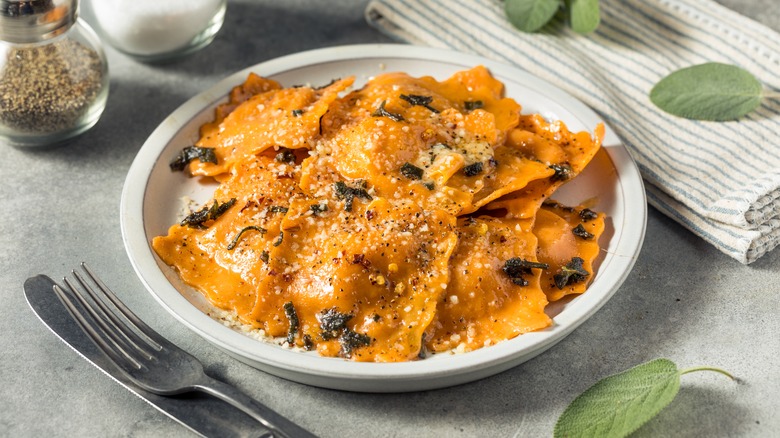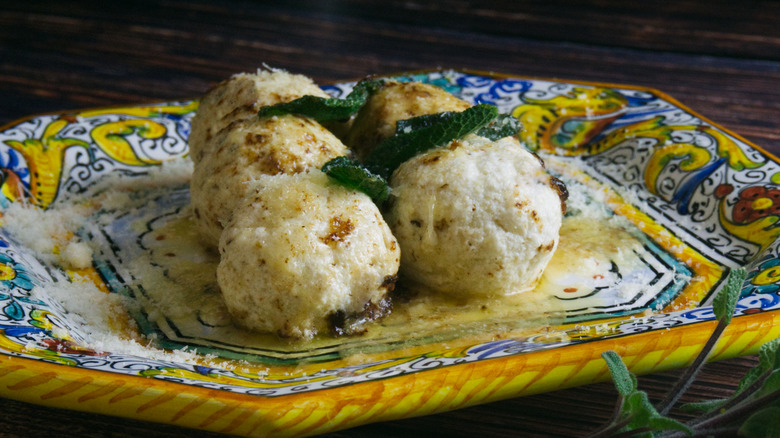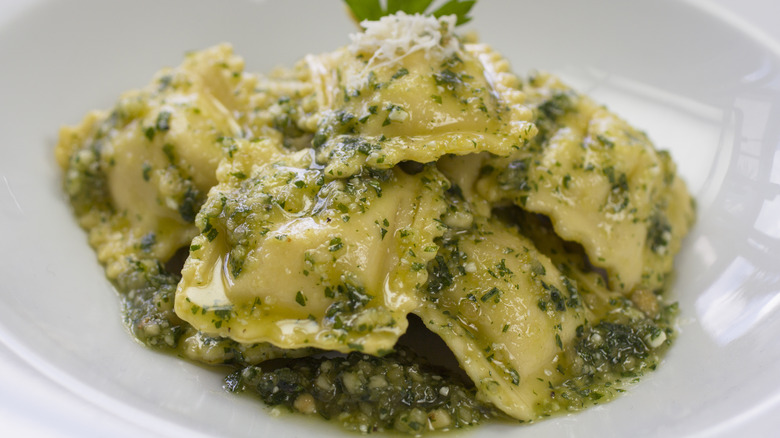Gnudi Vs Ravioli: Is There A Distinction?
Ingrained in Italian culture, pasta has been a favorite for thousands of years. One of the most popular stuffed varieties is the ravioli, which is made by encasing meat, cheese, and/or vegetables between two thin pieces of dough. Among the many facts you should know about ravioli, aside from the filling they can be customized into circles, crescents, or squares of different sizes. Although they appear to be related, gnudi is a variation with one major distinction: It's not technically pasta.
Ravioli and gnudi are sometimes confused because they both look like dumplings and share a Tuscan background. Whereas ravioli consists of a filling wrapped in pasta dough, gnudi doesn't contain pasta at all. In the Tuscan dialect, the term "gnudi" literally means "naked," which is a reference to the dumpling looking like ravioli filling cooked without the pasta shell. Outside of Tuscany, these rolled balls are called "malfatti," which translates to "badly done."
Gnudi is often confused with gnocchi, a smaller Italian dumpling that primarily consists of potato or flour. Those ingredients make gnocchi more chewy and firm, compared with gnudi which features ricotta, a creamy, soft cheese as the main ingredient. That's why in some parts of Italy, gnudi is referred to as "gnocchi di ricotta e spinaci," which means "ricotta and spinach gnocchi."
Making and getting creative with gnudi
Traditionally, ricotta is the focal ingredient in gnudi, but spinach may also be added. You'll want to use fresh ricotta from a specialty market because it doesn't contain stabilizers to artificially thicken milk solids, which make it harder to drain excess water from the cheese. Being able to squeeze out the extra liquid with a cheesecloth helps the gnudi hold together.
Additionally, gnudi is made with egg, spices, grated Parmesan, and a couple of tablespoons of flour. Rolling the ingredients into balls is the simple part, because the lack of a pasta shell means they can easily fall apart when you place them into boiling, salted water or broth. To avoid that pitfall, gently roll them in flour, place them on a lined baking sheet, and let them rest in the refrigerator for at least an hour or up to 24 hours. While resting, the gnudi will develop a semi-firm shell that shields the creamy insides while cooking.
Typically, gnudi is served with a brown butter and sage sauce and topped with a Parmesan or Pecorino Toscano sprinkle. However, you don't have to stick to the traditional flavor profile. You can serve gnudi in a simple tomato sauce and sprinkle it with your favorite cheese instead. Get creative by adding garlic and parsley like in this butter toasted ricotta gnudi recipe. Chilis and onions infuse a bolder flavor, whereas incorporating burning wood chips to the cooking process transforms the dish into smoked ricotta gnudi.
Making and getting creative with ravioli
Since the 14th century, ravioli has been an Italian staple enjoyed by all, particularly in the Northern regions of the country. This pasta is made by rolling out a very thin piece of dough and cutting it into pieces, which can vary in shape. A piece of dough is topped with the filling, covered with another piece of pasta, and then crimped around the edges to form a sealed pillow.
On the other hand, you could roll out a sheet of dough, space the filling over the surface, lay another dough sheet on top, and then use a crimping-style pasta cutter to separate each square. Either way, crimping ensures the filling stays in and the water stays out while the ravioli boils. After cooking, keep in mind Ina Garten's pro-tip to prevent ravioli from sticking together: Lay them out on large plates to rest before putting them in a sauce.
Ravioli is so customizable and you can do a lot with it. In fact, each region in Italy has its own recipe. Alongside having various filling options, light and heavy sauces can be used — from simple butter and cream to tomato sauce or broth. You can even turn your pasta into chocolate ravioli. If you don't have time to make it from scratch, there are ways to elevate canned ravioli or even turn frozen ravioli into lasagna.


